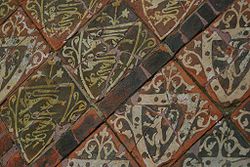
Encaustic tile
Encyclopedia


- For encaustic painting see Encaustic paintingEncaustic paintingEncaustic painting, also known as hot wax painting, involves using heated beeswax to which colored pigments are added. The liquid/paste is then applied to a surface—usually prepared wood, though canvas and other materials are often used...
Encaustic tiles are ceramic
Ceramic
A ceramic is an inorganic, nonmetallic solid prepared by the action of heat and subsequent cooling. Ceramic materials may have a crystalline or partly crystalline structure, or may be amorphous...
tile
Tile
A tile is a manufactured piece of hard-wearing material such as ceramic, stone, metal, or even glass. Tiles are generally used for covering roofs, floors, walls, showers, or other objects such as tabletops...
s in which the pattern or figure on the surface is not a product of the glaze
Ceramic glaze
Glaze is a layer or coating of a vitreous substance which has been fired to fuse to a ceramic object to color, decorate, strengthen or waterproof it.-Use:...
but of different colors of clay
Clay
Clay is a general term including many combinations of one or more clay minerals with traces of metal oxides and organic matter. Geologic clay deposits are mostly composed of phyllosilicate minerals containing variable amounts of water trapped in the mineral structure.- Formation :Clay minerals...
. They are usually of two colors but a tile may be composed of as many as six. The pattern is inlaid into the body of the tile, so that the design remains as the tile is worn down. Encaustic tiles may be glazed or unglazed and the inlay may be as shallow as an eighth of an inch, as is often the case with "printed" encaustic tile from the later medieval period, or as deep as a quarter inch.
History
What were called encaustic tiles in the Victorian eraVictorian era
The Victorian era of British history was the period of Queen Victoria's reign from 20 June 1837 until her death on 22 January 1901. It was a long period of peace, prosperity, refined sensibilities and national self-confidence...
were originally called inlaid tiles during the medieval period. The use of the word "encaustic" to describe an inlaid tile of two or more colors is technically incorrect. The word encaustic from means "burning in" from the ἐν - en "in" and καίειν - kaiein "to burn". The term originally described a process of painting with a beeswax
Beeswax
Beeswax is a natural wax produced in the bee hive of honey bees of the genus Apis. It is mainly esters of fatty acids and various long chain alcohols...
-based paint that was then fixed with heat. It was also applied to a process of medieval enameling. The term did not come into use when describing tile until the nineteenth century. Supposedly, Victorians thought that the two color tiles strongly resembled enamel work and so called them encaustic. Despite the error, the term has now been in common use for so long that it is an accepted name for inlaid tile work.
Encaustic or inlaid tiles enjoyed two periods of great popularity. The first came in the thirteenth century and lasted until Henry the Eighth
Henry VIII of England
Henry VIII was King of England from 21 April 1509 until his death. He was Lord, and later King, of Ireland, as well as continuing the nominal claim by the English monarchs to the Kingdom of France...
's reformation in the sixteenth century. The second came when the tiles caught the attention of craftsmen during the Gothic Revival era, who after much trial and error mass-produced these tiles, made them available to the general public. During both periods tiles were made across Western Europe though the center of tile production was in England
England
England is a country that is part of the United Kingdom. It shares land borders with Scotland to the north and Wales to the west; the Irish Sea is to the north west, the Celtic Sea to the south west, with the North Sea to the east and the English Channel to the south separating it from continental...
. Companies in the United States also made encaustic tile during the Gothic Revival architecture
Gothic Revival architecture
The Gothic Revival is an architectural movement that began in the 1740s in England...
style's period. The American Encaustic Tiling Company of Zanesville
Zanesville, Ohio
Zanesville is a city in and the county seat of Muskingum County, Ohio, United States. The population was 25,586 at the 2000 census.Zanesville was named after Ebenezer Zane, who had constructed Zane's Trace, a pioneer road through present-day Ohio...
, Ohio, was active until the 1930s.

